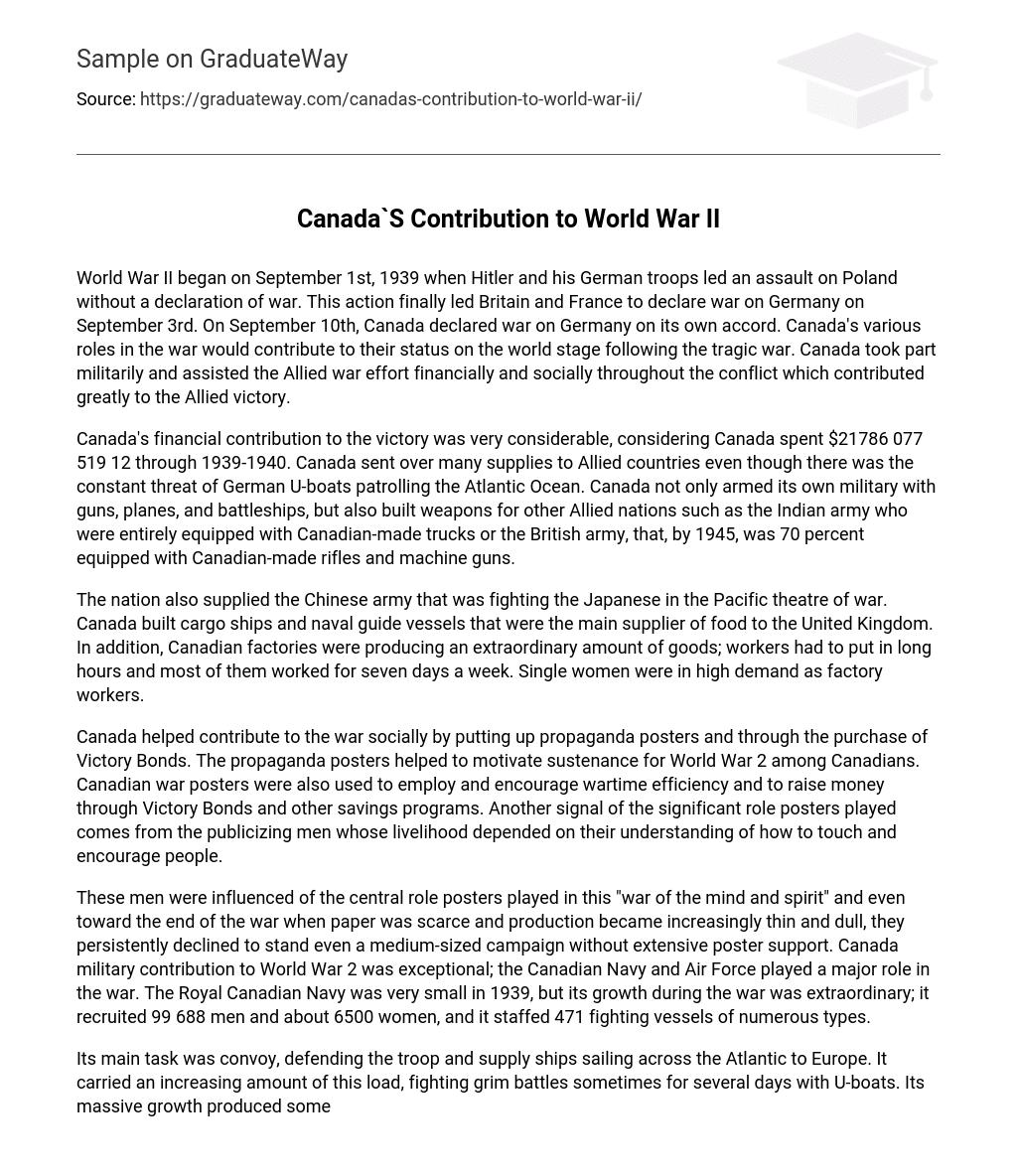World War II started on September 1st, 1939, with Hitler and his German troops attacking Poland without declaring war, resulting in Britain and France declaring war on Germany on September 3rd. Subsequently, on September 10th, Canada independently declared war on Germany. Canada’s involvement in the war had significant implications for its global reputation. In addition to participating militarily, Canada played a crucial role in the Allied war effort by providing financial and social assistance, ultimately contributing to the triumph of the Allied forces.
Canada made a significant financial contribution to the victory, spending $21786 077 519 12 during 1939-1940. Despite the constant threat of German U-boats in the Atlantic Ocean, Canada provided supplies to Allied countries. In addition to arming its own military with guns, planes, and battleships, Canada manufactured weapons for other Allied nations. For example, the Indian army was fully equipped with Canadian-made trucks, while the British army was 70 percent equipped with Canadian-made rifles and machine guns by 1945.
Canada supplied the Chinese army in the Pacific theatre of war against Japan. They built cargo ships and naval guide vessels for the United Kingdom’s main food supply. Canadian factories were extremely productive, requiring workers to put in long hours, including seven days a week. Single women were highly sought after as factory workers.
In Canada, during World War 2, the country made social contributions through the use of propaganda posters and by investing in Victory Bonds. These posters were effective in motivating support for the war among Canadians, as well as promoting wartime efficiency and raising funds. The importance of these posters is evident through the individuals who relied on their ability to connect with and inspire others.
During World War 2, these individuals were influenced by the significant role that posters played in the war’s mental and spiritual aspect. Even when resources were limited and production was diminished, they consistently relied on extensive poster support for their medium-sized campaigns. Canada made an exceptional military contribution to this war, with the Canadian Navy and Air Force playing major roles. In 1939, the Royal Canadian Navy was quite small, but its growth during the war was remarkable. It recruited 99 688 men and approximately 6500 women, and it manned 471 fighting vessels of various kinds.
The main objective of the RCAF (Royal Canadian Air Force) was to protect and escort troop and supply ships traveling from the Atlantic to Europe. It took on an increasing amount of this responsibility and engaged in intense battles with U-boats for extended periods of time. As it expanded, it encountered some challenges. Throughout the war, the RCAF played a role in sinking 33 enemy submarines. Initially, the RCAF had eight permanent working squadrons, but by October 1939, Canada had a total of 15 squadrons – 12 for defending the homeland and 3 for serving overseas.
During this period, the Air Force had a total of 20 aircraft types, with half dedicated to training or transport. In January 1944, the Royal Canadian Air Force (RCAF) reached its peak strength with 215,000 personnel across all ranks. By the end of World War II, Canada emerged as the fourth largest air force in the world. The war ended with Germany surrendering in Italy on April 29, 1945 and in Western Europe on May 7, 1945. On the Eastern Front, Germany surrendered to the Soviets on May 8, 1945.
Canada played a crucial role in the war against the Axis Powers, both militarily and financially. The Royal Canadian Navy excelled at sea while the Royal Canadian Air Force dominated the skies. Canada also made a significant financial contribution of $2,178,607,751,912. Victory Bonds were instrumental in raising funds for the war effort and propaganda posters inspired enlistment among young men for overseas combat. Despite its size, Canada’s exceptional support was vital to securing victory for the Allies.
Bibliography
“Canadian Air Force History – War Years.” RCAF.com :: The History & Heritage of Canada Air Forces. Web. 25 May 2011.
. C. P. STACEY. The Canadian Encyclopedia. Web. 25 May 2011.
. Hillman, William. “Canadian WWII Propaganda Posters.” British Commonwealth Air Training Plan: WWII CATP Air Museum. Web. 25 May 2011.
.





